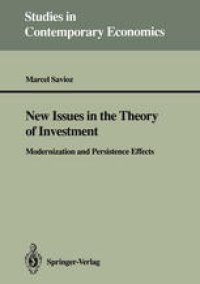
Ebook: New Issues in the Theory of Investment: Modernization and Persistence Effects
Author: Dr. Marcel Savioz (auth.)
- Tags: Economics general
- Series: Studies in Contemporary Economics
- Year: 1992
- Publisher: Springer-Verlag Berlin Heidelberg
- Edition: 1
- Language: English
- pdf
The investment good market, together with the consumer good market, the money market and the labour market, are indeed the most extensively studied markets. The exhaustive survey of investment theory by Eisner and Strotz, already quoted four hundred references in 1963, although this work advocating for adjustment costs, was in fact only carried out at the very beginning of modern investment theory! This chapter gives an introduction of the extensive field and is an attempt to present some key ideas of investment theory. 1) We show that modern investment theory is the integration of many traditional approaches. The content of the chapter is set as follows. Section 2 presents an illustrative model of investment theory. Section 3, using this model, describes the investment decision of the firm. Sections 4 to 10 each present a "classical" investment hypothesis within the framework of the model. Section 11 concludes. For convenience, the key to the symbols used is given in Table 1. 2. The Model of the Firm Investment theory was born with the claim of Keynes (1936) that besides the capital demand (demand for a stock of capital at a point in time), an investment demand (demand for the increment of the capital stock in a period 1) Recent surveys are: Abel (1988), Coen and Eisner (1987) Artus and Muet (1984). The book on investment theory by Nickell (1978) is outstanding.
This monograph starts with a survey of the One-Relative- Price (Q value) Theory of Investment and then explores the richness of the Many-Relative-Price Theory of Investment: Firstly a tractable model of modernization investment is presented which recognizes that in modern economies more than half of the gross investments consists of replacement investments, and that the main motive for replacement investments is to modernize the capital stock. This model predicts that an activation of investments by fiscal policy is only possible at the cost of causing an ageing of capital stock. Secondly a model is presented in which initial over- or underinvestments cause further over- or underinvestments and thus have a persistent effect on the structureof the capital stock. This model explains why in centrally planned economies a rapid and persistently extensive growth was possibleand had to be followed by stagnation.